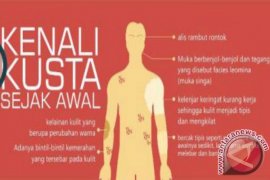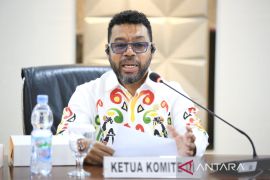8.3 in 100,000 population.Jakarta (ANTARA News) - Although Indonesia has managed to reach leprosy elimination stage, the country has not been able to completely eradicate the disease.
The leprosy elimination level in Indonesia reached less than one in 10,000 sufferers in 2000 whereas there were 14,000-20,000 new reported leprosy cases each year with no sign of significant decline.
In 2011, the Ministry of Health reported 20.023 new leprosy cases or 8.3 in 100,000 population.
"Nationally it is not perceived as severe, because it is less than one in 10,000, but we should not underestimate it," Health Minister Nafsiah Mboi said in Tangerang, Banten, on Wednesday.
Indonesia observed the 60th World Leprosy Day on Wednesday at Dr Sitanala leprosy hospital in Tangerang where the health minister opened a workshop on Empowerment of People who Have Ever Had Leprosy, and then dedicated a leprosy clinic services integrated building.
Leprosy has been around since the beginning of time, often surrounded by terrifying, negative stigma and tales of leprosy patients being shunned as outcasts.
But it is actually not highly contagious because its incubation period is more than 20 years.
A person can catch the disease only if he or she comes into close and repeated contact with nose and mouth droplets from untreated lepers.
The main symptom of leprosy is disfiguring skin sores, lumps, or bumps that do not go away after several weeks or months with the skin sores are pale-colored.
But without treatment, the disease can lead to permanent nerve damage and muscle paralysis.
Therefore, Nafsiah said that in the future the Ministry of Health will step up preventive acts to address the leprosy cases in the country.
Besides, the health minister expressed hope that early detection could be more intensive to speed up recuperation and prevention of the disease.
"The Community Health Centers (Puskesmas) should have conducted early detection of leprosy because it is so simple to do so," she said.
According to the minister, leprosy is is now preventable and treatable through a very simple way of clean and healthy behavior.
"Leprosy is no longer a mysterious disease. It is infectious disease that can be prevented and treated with clean and healthy lifestyle," the minister said.
During the commemoration of World Leprosy Day in February 2012,
Coordinating Minister for People`s Welfare Agung Laksono said the high number of leprosy cases in Indonesia was due to a stigma and discrimination against cured lepers.
Consequently, he said it was hard to reach the people living with leprosy for treatment.
According to a survey in 5 districts in Indonesia by the Ministry of Health & Human Rights National Commission, the discrimination faced by cured people includes rejection at school and workplace, difficulty in getting a job, and rejection at health centers.
But now Health Minister Nafsiah Mmboi has prohibited the community to give the stigma and discrimination against the sufferers of leprosy, because she said the disease did not not affect a person`s ability to work.
"There is no reason to stigmatize and discriminate the lepers and those who have been cured, because the disease is preventable and treatable," Nafsiah noted.
She added that even the defective leprosy sufferers could also be rehabilitated to make them able to work like normal people.
According to World Health Organization (WHO) latest report in September 2012, high leprosy endemic remains in some areas of Brazil, Indonesia, the Philippines, Democratic Republic of Congo, India, Madagascar, Mozambique, Nepal, and the United Republic of Tanzania.
All endemic countries remain highly committed to eliminating the disease, and continue to intensify their leprosy control activities.
WHO said leprosy control has improved significantly due to national and sub-national campaigns in most endemic countries.
"Integration of primary leprosy services into existing general health services has made diagnosis and treatment of the disease easy," WHO said.
The implementation of the global leprosy strategy 2011-2015 national leprosy programmes now focus more on undeserved populations and inaccessible areas to improve access and coverage.
Since control strategies are limited, national programmes actively improve case holding, contact tracing, monitoring, referrals and record management.
At local level, 14 of 33 provinces, and 150 of 479 districts in Indonesia have new leprosy cases of more than 10,000 per year.
Leprosy is frequently associated with poverty and backwardness in development, and remained a health hazard to the people in 14 Indonesian provinces.
Therefore, Ministry of Health director-general of disease control and environmental health Tjandra Yoga Aditama, said in September 2012 that Indonesia had yet to be able to completely eradicate leprosy.
"We have been able to reach leprosy elimination stage since 12 years ago but we have not completely eradicate the disease," Tjandra said at the time.
According to him, the number of leprosy cases was not very high but effort to eradicate it completely was not a simple task to carry out.
(O001)
Reporter: Otniel Tamindael
Editor: Ella Syafputri
Copyright © ANTARA 2013











